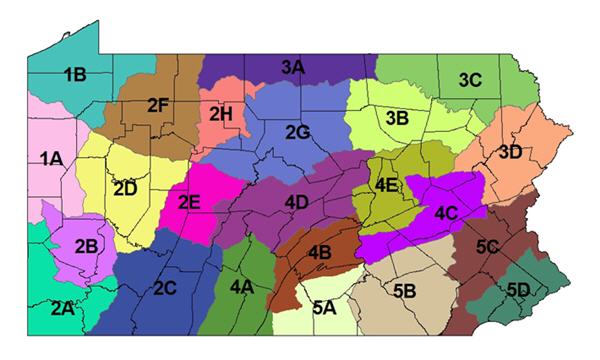Why Bigger is Better
Wildlife Management Units
We have all heard the saying bigger is better. But when it comes to Wildlife Management Units (WMUs), some disagree. The size of Pennsylvania's WMUs remains a point of contention. Logically, small management areas appear to be a better alternative. Deer populations, land-cover, and landowner values vary at small scales. So, why not manage deer using smaller WMUs?
The state's 23 WMUs comprise basic geographic regions delineated to improve deer management. All of the WMUs are bounded by easily recognized roads and rivers. From one neighboring unit to the next there are differences in landscape features and composition, land use practices, landownership, and human density. As a result of these differences, each WMU's capacity to support deer varies. Deer population data are collected in each WMU to monitor population trends and measure management indicators.

Reliable data must be collected to properly manage Pennsylvania's deer. The Game Commission has several choices for gathering these data. First, it could divide the state into a large number of small units. But this choice does not allow for enough data to be collected to support management recommendations. Second, the agency could divide the state into a large number of small units, but group the small units into larger units for management purposes. This approach would generate sufficient data to support management recommendations, but treats unlike units equally. Finally, the Game Commission could create fewer, larger management units that provide enough dependable data to adequately support recommendations and treat each management unit separately.
The first choice is not a viable option for a responsible deer management program as management actions could not be supported. The second choice describes the Game Commission's use of counties prior to 2003. Although the state contains 67 counties, counties were grouped into 31 "units" in order to have a large enough data set for deer management purposes. The third choice is the Game Commission's preferred option and the system that is currently in place. It most clearly conveys how deer management is applied to the different areas of the state, and it provides adequate data for management recommendations.
Critics of Pennsylvania's large management units often point to other states that have large numbers of deer management units as a better option than Pennsylvania's method. However, deer biologists in these states face the same problem of inadequate data at small scales. The following quote is from Wisconsin's Department of Natural Resource's "Management workbook for white-tailed deer".
"It is commonly believed that smaller units result in more precise management, but the opposite is usually true. Fragmentation of units reduces precision of herd monitoring capability because sample sizes (age data, hunting pressure, and productivity) are smaller and subject to more inaccuracy. A simple split of a unit has the effect of increasing the imprecision of survey data by more than 40%, all else being equal. A change in any exterior unit boundary also compromises the unit history of at least one adjacent unit.....
...To account for smaller units, biologists must extrapolate from data in other nearby similar units and pool data from groups of units (or from several years) to attain sufficient sample sizes for analysis of trends. Pooling of data defeats one of the purposes of creating smaller units, by masking unit-specific trends."
Wisconsin has more than 130 deer management units. Three problems surface immediately in their management unit approach. First, small management units are inadequate for data collection. Second, having a large number of small management units does not prevent calls for even more and smaller management units. Finally, a large number of small management units will not satisfy deer hunters or stop disagreements over data results or management practices.
Currently, the resources are not available to collect enough data to support a large number of small management units. But the Game Commission has considered all the important factors that make up Pennsylvania's diverse landscape and created Wildlife Management Units that are being used to effectively manage deer and other species.